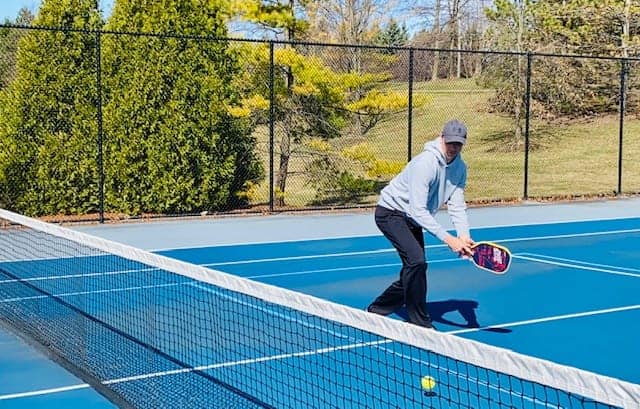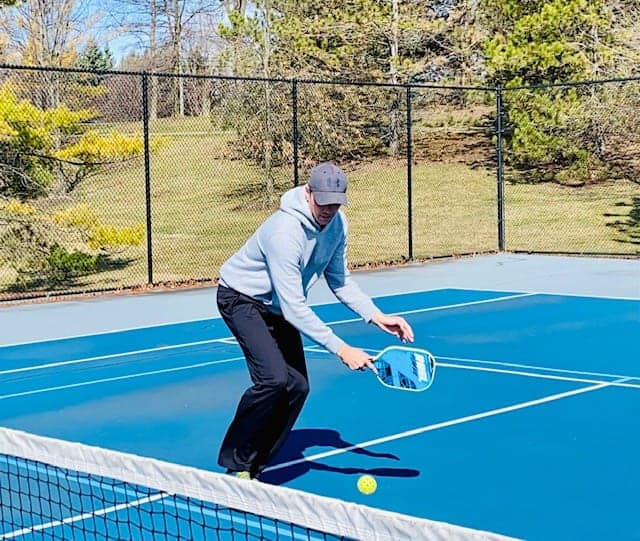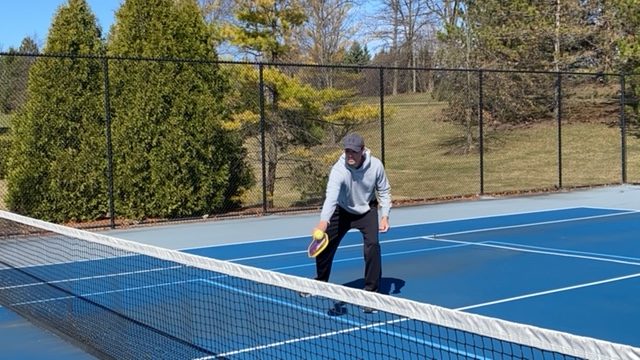What Is The Kitchen In Pickleball? A Simple Answer For Beginners
What Is The Kitchen In Pickleball – The Rules
Fun Fact: There are 11 individual rules associated with the kitchen in pickleball. Yes 11! So, there’s more to it than you think. Let’s break it down.
For some fantastic bathroom reading (I’m being sarcastic) here is a link to the International Federation of Pickleball and their complete rule book. Scroll down to section 9 for all 11 rules around the kitchen or non-volley zone.
But reading a PDF from an official pickleball governing body is boring. Let me paraphrase it and make it fun for you.
A more abbreviated synopsis read like this:
“The non-volley zone is the 7-foot zone on both sides of the net. No volleying is permitted within the non-volley zone. This rule prevents players from executing smashes from a position within the zone. When volleying the ball, the player may not step on or over the line. It is a fault if the player’s momentum causes the player or anything the player is wearing or carrying to touch the non-volley zone. It is a fault even if the ball is declared dead before the player touches the zone. A player may be in the non-volley zone at any other time. The non-volley zone is sometimes referred to as the kitchen.” – The IFP
– The Basic Kitchen Rule –
As the quote above states, the most basic rule involving the kitchen in pickleball is simply that in order to hit the ball in this area of the court, the ball has to bounce first. All volleying must take place outside the kitchen line.
For a complete guide to volleying, check out this helpful guide.
Meaning, when you’re in the kitchen, you are only permitted to hit groundstrokes. In fact, it’s the only area that enforces this ground stroke only concept.
If you want to hit a volley out of the air, you must be behind the kitchen line. It’s that simple.
But, there are some other more obscure rules associated with the kitchen in pickleball. I didn’t know some of these, and I’ll bet you most of the players you play with don’t know them either.

Since the ball bounced first in the kitchen, I can step in and hit it back legally.
– Lesser Known Rules Behind The Kitchen In Pickleball –
1. It is NOT illegal to stand in the kitchen during a pickleball match? Yep. Totally legal.
In fact section 9E of the rule book reads like this: “A player may enter the non-volley zone at any time except when that player is volleying the ball.”
But the main rule of groundstrokes only still applies. Meaning, you can stand there all you want but if you’re going to hit the ball, it’s got to bounce first.
So, if you’re just camping out in the non-volley zone area and the ball is hit hard at you. It has to bounce before you hit it. So basically, you can’t hit it and have effectively become target practice for your opponent. If that ball hits you anywhere before bouncing, the point is over. You lose.
So, it’s in your best interest to not set up shop in the kitchen. Stand at the kitchen line like everybody else.
This brings me to my second lesser known rule.
2. It is a fault if any part of the volleying player or anything touching the volleying player comes into contact with the kitchen or kitchen line.
So, this means that if you’re standing properly at the kitchen line, but your toe touches the line while hitting a volley; it’s a fault. If your partner is inside the kitchen or on the line itself and you (who are outside the kitchen line) accidentally touches your partner while volleying, it’s a fault.
But perhaps the most crazy part to this rule is that even if you’re outside the kitchen line while volleying, but your hat or visor falls into the kitchen – it’s a fault.
A player cannot drop or throw anything into the kitchen they are wearing or holding, which can include your hat or sunglasses, and of course, your paddle. It can also include anything in your pockets, such as a wallet, keys, or chapstick.
What if you’re not hitting a volley shot but you accidentally cross the line or your hat falls into the kitchen? Well, that’s totally fine. That’s not a fault because you’re not in the processing of executing a volley.
These rules only apply if you’re attempting to hit the ball on fly out of the air.
3. The final lesser known rule about the kitchen in pickleball is that if you’re in the no-volley zone and have to hit a volley shot, both feet must first come in contact with surface outside of the no-volley zone before hitting the ball.
So if you’re in the kitchen and want to jump and smash it, you must first completely exit the kitchen with both feet before smashing. Which sounds almost impossible.
Again, all the more reason to stand outside the kitchen line when playing pickleball.

Why Do We Have The Kitchen In Pickleball?
Pickleball is one of the fastest-growing sports in America because it is a fast-paced and unique game that can be played by people of all ages and has simple rules that anyone can follow. While many of them are relatively easy to learn, there is one rule that many players may not fully understand and it has to do with the kitchen. So, what is the kitchen in pickleball?
The kitchen in pickleball is the seven feet of court on either side of the net, known as the “no-volley zone.” This section of the court is usually a different color to signify its boundary and only allows for groundstroke shots. Aside from eliminating volleys, there is actually way more to the kitchen in pickleball than you realize.
In fact, you may be mistaken about some of the rules. I certainly was.
Keep reading. Trust me, there’s WAY more to the kitchen than meets the eye.
Why do we have the kitchen in pickleball? What is the reasoning behind it?
Whether you are new to pickleball or have played for quite some time, I’m going to go over everything you need to know about the infamous “kitchen” in pickleball.
Let’s dive in!
Once you’ve combed through and fully understand the rules about the kitchen line in pickleball, it’s easy to better understand why we have this rule.
It was put into place to keep players from standing at the net and just smashing anything that came their way. You can do this in tennis because the court is so much bigger. But that does’t work in pickleball.
In fact, the kitchen rules in pickleball where created because one of the first players of the sport used this strategy to use his height as unfair advantage.
Yes, one of the game’s original players tried to cheat…in a friendly way.
Barney McCallum and Joel Pritchard, two of the game’s inventors had a friend who also loved to play the game. His name was Dick Brown. Dick stood 6 fehttps://thevolleyllama.com/history-of-pickleball/et 4 inches tall and as the families began to flush out the rules of the sport on the fly they quickly had to out a spot to Dick’s aggressive play at the net.
The no-volley zone or kitchen line was created so Dick couldn’t stand at the net and smash everything in sight. And hence, the kitchen line was born.
Pickleball Kitchen Strategies – Where Should You Stand?
Despite the dangers of going too close to the no volley zone, a smart and common strategy for pickleball players is to stand as close to the kitchen line as possible.
This strategy is called “toeing the line.”
Generally, you want to be as close to this line as possible to increase your ability to have controlled and accurate hits. Toeing the line can be intimidating to beginners at first, because it feels like you’re going to get a ball blasted at you.
When standing at the kitchen line, it may feel like you’re in the line of fire. But trust me, that’s where you want to be. In fact, pickleball as whole is generally played at either the baseline line or the kitchen. Not in between.
New players may feel like it’s safer to play in between the kitchen line and the baseline at first. But this is no mans land and its NOT where you want to be because it allows for your opponents to hit at your feet more easily.
Hitting at your opponent’s feet is a game changer of a strategy and you can read more about it here.

This is an example of playing not quite at the kitchen line.

This is a better example of toeing the line and being ready at the net.
Why Is It Called the Kitchen?
Beginning pickleball players tend to get confused about all of the kitchen rule complexities.
To begin with, the kitchen seems like an odd name for something related to pickleball, but no one quite seems to know why the no volley zone got such a quirky name, although there are some theories.
One such theory is that the three dads that invented it just thought it was a silly name.
However, a more plausible theory suggests that it comes from a term used in shuffleboard. This is a more likely version of events because other components of the game were borrowed from shuffleboard as well, such as the net.
In badminton, there is also a term in the game called the kitchen, which is an area behind the scoring zone in which players will lose 10 points if they land their puck in. It is also known as the “10-off” zone in the sport.
What Is The Kitchen In Pickleball – Final Thoughts
Wondering what is the kitchen in pickleball is a common question for new players. But as you now know, it’s not as simple as it sounds. There are many nuances to the kitchen line in pickleball and understanding the subtitles. behind them can help you be a better player at the net.
And hey, you might even be able to impress your friends with some not-so-common but lesser known facts about being in the kitchen during a game.
Whether you’ve played pickleball for a while or you are still figuring things out, understanding the rules of the kitchen line can significantly improve your game.
About Me
I’m just a lover of all sports that involve a racquet, net and a ball. My whole family loves and plays pickleball regularly. I started this website to help give people like you the performance tips and buying info they need to make an educated and informed purchase.
The products I recommend here have been researched, analyzed, compared and in a lot of cases bought, worn and used. If it’s a bad product, I don’t recommend it. Any small purchase made from this site gives me a small commission that helps fund the growth of the site to provide you more helpful information.

Welcome to TheVolleyLlama.com. My name is Keith, I’m just a lover of all sports that involve a racquet, net and a ball. I played competitive high school varsity tennis, love racquetball and my whole family plays pickleball regularly. I started this website to help give people like you the basics to learn these wonderful games.


